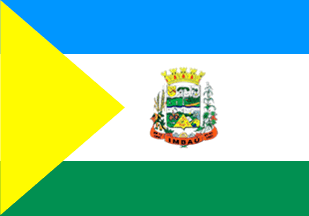 image by Ivan Sache, 3 February 2022
image by Ivan Sache, 3 February 2022
Last modified: 2022-03-05 by ian macdonald
Keywords: parana | imbaú |
Links: FOTW homepage |
search |
disclaimer and copyright |
write us |
mirrors
 image by Ivan Sache, 3 February 2022
image by Ivan Sache, 3 February 2022
The municipality of Imbaú (13,282 inhabitants in 2020; 33,120 ha) is located
220 km north-west of Curitiba.
Imbaú was established in the 1960s during
the construction of asphalted road BR-376 (Coffee Road) by the Cirol company.
Originally named Cirol, the town was renamed to Imbaú, from a Tupi-Guarani word
meaning "a drink from the tap", referring to the two rivers that water the
municipality, Imbaú and Imbauzinho.
The municipality of Imbaú was established
by State Law No. 11,220 promulgated on 8 December 1995, separating from Telêmaco
Borba.
http://imbau.pr.gov.br/
Municipal website
The flag and arms of Imbaú are prescribed by Municipal
Law No. 9 promulgated on 9 July 1997.
Article 6.
The flag of the
municipality of Imbaú, designed in compliance with the norms and templates
prescribed by Law No. 5,700 promulgated on 1 August 1942, has the following
characteristics.
- A yellow (or) irregular triangle and three irregular
horizontal stripes, the upper one, blue (azure), the lower one green (vert), and
the central one white charged with the municipal coat of arms. The upper blue
(azure) part symbolizes the firmament and the blue sky that covers the territory
of the municipality of Imbaú. The green (vert) lower part of the rectangle
symbolizes Imbaú people's hope in progress and achievements by administrators
and legislators; it also represents the vast plains, rainforest and reforested
areas, as well as the municipality's whole rural area. The white (argent) stripe
symbolizes peace, faith, religious spirit and progress of the laborious people
of the municipality of Imbaú. The yellow (or) irregular triangle symbolizes the
natural resources of the municipality of Imbaú. On the white stripe, in the
rectangle's center, is applied the coat of arms that represents the municipal
government and its spread to all parts of the municipal territory.
§1. In
compliance with heraldic rules, the municipal flag of Imbaú has the official
dimensions prescribed for the national flag, 14 units in width on 20 units in
length.
Article 18.
The coat of arms of the municipality of Imbaú has
the following characteristics.
A shield in classical Flemish Iberian style,
of French origin introduced to Iberia during the struggle against the Moors,
representing in Portuguese armorials domains' heraldry; inherited by Brazilian
heraldry, this style evokes the colonizing race and main builder of the nation.
The mural crown is a universal symbol of domains; yellow (or) with eight towers,
only five of them visible in perspective view, it classifies a 3rd rank town,
seat of a municipality. The red windows, through the heraldic meaning of this
color, recall the proper attributes of the pioneers and leaders of Imbaú
community.
The shield's field is divided into four quarters, two escutcheons
and a triangular area, the upper and lower parts being separated by a blue
sinuous line. The escutcheon placed in the shield's upper left part features a
book representing the Bible, the guide that leads us closer to God. The
escutcheon in the right part features a book, a terrestrial globe, an inkpot and
a quill, which represent education and culture in the municipality. Dividing the
two upper quarters, a Paraná pine (Araucaria), as the symbol of the state of
Paraná. In the first upper left quarter the representation of the onset of
colonization, when land was cultivated with plows and man-powered machinery,
with colonists sowing their crops. In the second, right quarter, vast green
(vert) pine reforested areas, one of the municipality's sources of income. The
blue sinuous line symbolizes the rivers and brooks that irrigate the rich lands
of the municipality of Imbaú. The third quarter features a farmer cultivating
his land with a tractor. The fourth quarter features heads of an ox, a pig, and
a sheep, which represent livestock in the municipality of Imbaú. The triangular
area features a yellow (or) beehive with honey and a bee, recalling that the
municipality of Imbaú is one of the region's largest honey producers. The hive
and the bee are the symbol of work, thus symbolizing the working people of the
municipality of Imbaú. Beneath the shield and above the scroll a gear symbolize
the existing industries in the municipality. The shield is supported left by
soybean and wheat, right by beans and corn, these crops being the municipality's
main source of income. The red scroll is inscribed with the toponym "IMBAÚ",
surrounded left by date "08.12.1995", the day, month and year of emancipation of
the municipality of Imbaú, and right by date "01.01.1997", the day, month and
year of inauguration of the first Mayor of Imbaú.
https://leismunicipais.com.br/a/pr/i/imbau/lei-ordinaria/1997/2/13/lei-ordinaria-n-13-1997-institui-os-simbolos-do-municipio-e-da-outras-providencias
Leis Municipais database
Photos
https://www.facebook.com/prefeituraimbau/photos/1248684658898436
https://www.facebook.com/prefeituraimbau/photos/1291214601312108
https://www.facebook.com/prefeituraimbau/photos/824687897964783
Ivan Sache, 3 February 2022